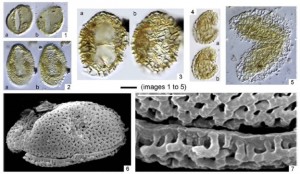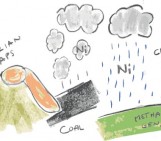 This is a guest post by Dan Peppe. He is an Assistant Professor in the Geology Department at Baylor University. His research interests are focused on reconstructing ancient climates and ecosystems in North America and East Africa and on developing new and improved palaeoclimate and palaeoecological proxies using methods in paleobotany, sedimentary geology, and paleomagnetism. More information about Dan and his research can be found on his website: www.danielpeppe.com. He also tweets about his research and other interests on his Twitter account (@danpeppe).
This is a guest post by Dan Peppe. He is an Assistant Professor in the Geology Department at Baylor University. His research interests are focused on reconstructing ancient climates and ecosystems in North America and East Africa and on developing new and improved palaeoclimate and palaeoecological proxies using methods in paleobotany, sedimentary geology, and paleomagnetism. More information about Dan and his research can be found on his website: www.danielpeppe.com. He also tweets about his research and other interests on his Twitter account (@danpeppe).
Over the last couple of weeks several blogs and news outlet have reported that a new study published in Frontiers in Plant Science (Hochuli and Feist-Burkhardt, 2013) shows that new fossil pollen push back the origin of flowering plants (angiosperms) by 100 million years to the early Triassic (e.g., LiveScience, BBC, ScienceDaily). The headlines and articles lead a reader to assume that there was new evidence showing that angiosperms were present in the Triassic (252-201 million years ago, Ma). However, the new study actually suggests something quite different that adds to a growing body of evidence pertaining to a larger narrative about the evolution of plants and the evolution of angiosperms.

Fossil charcoalified floras from a Late Cretaceous (Santonian, 86 – 83 Ma) in central Georgia showing amazing 3D preservation and anatomical detail. Images were taken using a scanning electron microscope and are considerably magnified (A magnified X50, B X100, C X20). Flower images are from Figure 4 of Crane et al. (2004).
The origin of angiosperms has puzzled scientists since at least the time of Darwin when he famously referred to it as an “abominable mystery.” In large part this confusion stems from the fact that angiosperms appear suddenly in the fossil record with no clear ancestors for perhaps as long as ~100 million years before their first occurrence. Despite extensive research on earliest angiosperms, there are few early angiosperm and “angiosperm-like” fossils and many of these fossils have a characteristics that define more than one modern group of plants. As a result, there is still a great deal of debate about when and where angiosperms first occurred and to which plant groups they are most closely related.
To make things more confusing, the early angiosperm fossil record and molecular dating of the timing of angiosperm origins don’t agree. On the fossil side, the oldest definitive angiosperm fossil pollen first appears in the Early Cretaceous, approximately 133-139 Ma, and the earliest definitive angiosperm fossil leaves and flowers first occur about 130-125 Ma. However, one of the confusing things about the fossil record is that many of the earliest angiosperm fossils appear to be somewhat derived and are from groups that are not at the base of the angiosperm phylogenetic tree. This suggests that angiosperms may have been present before the first fossil occurrences, but as of yet haven’t been found.

Examples of early angiosperm pollen from an early Cretaceous (Albian, ~100 – 115 Ma) site in Spain. Images 2, 6, and 7 are examples of monosulcate, columellate pollen. Pollen images from Plate I in Villanueva-Amadoz et al. (2010).
On the molecular dating side, molecular dating based on DNA sequences of modern angiosperms and gymnosperms (e.g., conifers) has resulted in a wide range of dates for angiosperm origins with most recent analyses suggesting early Permian (~275 Ma) to late Triassic (228-217 Ma) to Jurassic (183-147 Ma). To support these apparent “old” dates for angiosperm origins, it has been suggested that the first angiosperms may have lived in dark, wet, and disturbed understory tropical habitats in the Jurassic that did not preserve well in the fossil record. In this scenario, the radiation of angiosperms seen in the fossil record would mark the radiation of angiosperms out of dark and disturbed habitats.
At this point, the only way to resolve the discrepancy between the fossil record and molecular dating is to conduct detailed analyses of the Triassic and Jurassic records with an eye toward finding angiosperm and angiosperm-like plant fossils. This is where the study of Hochuli and Feist-Burkhardt (2013) comes in.
In their study, Hochuli and Feist-Burkhardt assessed pollen grains from a middle Triassic core collected from northern Switzerland. Using a standard transmitted light microscope and confocal laser scanning microscopy (CLSM), they described six distinct pollen types that have angiosperm-like features. The CLSM method allowed them to generate detailed images of the surface of the pollen grains and to assess the structure of the exine, which is the tough, resistant outer coat of the pollen grain. Characteristics of the exine are very useful for taxonomic classification and the exine in angiosperms is quite diagnostic.

Photos of pollen grains from Plate II in Hochuli and Feist Burkhardt (2013) showing images of pollen type IV that is monosulcate and columellate.
Each pollen type described is monosulcate, a pollen type produced by most seed plants and some angiosperms, and has columellar structures in the exine, which are a characteristic of angiosperm pollen. These characteristics are, as well as a few others, similar to early angiosperm pollen from the Early Cretaceous. However, there are important differences between these Triassic pollen and early Cretaceous angiosperm pollen. Interestingly, these new pollen types are also similar to two types described from similar-aged Triassic deposits in the Norwegian Barents Sea (Hochuli and Feist-Burkhard, 2004) suggesting that the group of plants making these pollen grains were relatively diverse and spanned a large ecological range.
Considering the differences between the Triassic pollen and definitively angiosperm pollen from the Cretaceous and the considerable gap in time between the Triassic and Cretaceous with no similar fossils, Hochuli and Feist-Burkhardt (2013) suggest that the newly described pollen grains represent a group of plants that were stem relatives of angiosperms. This means they’re ancestral to angiosperms, importantly, not actually within the group itself. Additionally, they suggest that the features found in all of the new and previously published pollen types (i.e., monosulcate grains and columellar structures) are either ancestral features of angiosperms or are characteristics of a previously unknown gymnosperm plant group the independently developed analogous structures.
There are two key things to take away from the Hochuli and Feist-Burkardt (2013) study. First, most of the headlines and articles about this study were misleading. The authors weren’t suggesting that angiosperms first occurred 100 million years earlier than previously suggested. Instead, they argued that the pollen types they found were closely related to angiosperms and perhaps even represent a group of plants that was one of the direct evolutionary precursors to flowering plants. I guess the take away message from this is that it pays to check out the actual original research and not just the headline about it.
Second, and more importantly, this study and others like it that describe monosulcate pollen grains from the Triassic and Jurassic are forming an important dataset of Triassic and Jurassic angiosperm-like fossils. The features found in these pollen grains have been considered to be hallmarks of angiosperms in the past. As more and more studies document new pollen types with some features that are angiosperm-like and other features that are not, we’ll be able to better tease apart which features are ancestral to angiosperms (i.e., occur in groups closely related to angiosperms and well as angiosperms) and which are truly diagnostic (i.e., only occur in angiosperms). Angiosperm-like pollen also suggests that it’s likely that different groups of plants were evolving angiosperm-like characteristics during the Triassic and Jurassic and from one of them, flowering plants evolved. Finally, and most importantly for the understanding of the origin of angiosperms, these angiosperm-like fossils suggest that the angiosperm stem lineage may date back into the Jurassic or Triassic.
Studies like that of Hochuli and Feist-Burkardt (2013) clearly illustrate that there is much to be learned about plants in the Triassic and Jurassic and that it might be possible to find that “first” pre-Cretaceous angiosperms. Only more discoveries of angiosperm and angiosperm-like fossils from Triassic to early Cretaceous aged rocks will help us finally determine when and where the “first” angiosperms occurred. So get out there and start searching for fossil plants!
References:
Crane, P.R., Herendeen, P. and Friis, E.M. (2004). Fossils and plant phylogeny. American Journal of Botany. 91, 1683-1699. doi: 10.3732/ajb.91.10.1683
Hochuli, P. A., and Feist-Burkhardt, S. (2004). A boreal early cradle of Angiosperms. Angiosperm-like pollen from the Middle Triassic of the Barents Sea (Norway). Journal of Micropalaeontology. 23, 97–104. doi: 10.1144/jm.23.2.97
Hochuli, P. A., and Feist-Burkhardt, S.. (2013). Angiosperm-like pollen and Afropollis from the Middle Triassic (Anisian) of the Germanic Basin (Northern Switzerland). Frontiers in Plant Science. 4. doi: 10.3389/fpls.2013.00344
Villanueva-Amadoz, U., Pons, D., Diez, J.B., Ferrer, J., and Sender, L.M. (2010) Angiosperm pollen grains of San Just site (Escucha Formation) from the Albian of the Iberian Range (north-eastern Spain). Review of Palaeobotany and Palynology 162: 362-381. doi: 10.1016/j.revpalbo.2010.02.014
For more information about the origin of angiosperms check out the recent review paper by Jim Doyle:
Doyle, J. A. (2012). Molecular and fossil evidence on the origin of angiosperms. Annual Review of Earth and Planetary Science. 40, 301–326. doi: 10.1146/annurev-earth-042711-105313



Pingback: FLOWER IN JANUARY 2014 – 2014
Pingback: Forum Friday, October 18 Edition « paleoaerie